Loyalty Program Strategy: How to Build the Ultimate Ecommerce Loyalty Program
Holding on to your customers and encouraging repeat purchases is a vital piece of the puzzle for ecommerce retailers. In this comprehensive guide to loyalty program strategy, we walk you through how to carefully curate a loyalty program for your Shopify brand that will boost customer retention and build a community of brand advocates.
Written By
Catherine Lambert

In today’s competitive ecommerce landscape, a significant challenge for any online retailer lies in not just attracting customers, but in keeping them. With an abundance of choice and tempting discounts available for consumers, securing their loyalty to your brand is no easy task.
This is especially important given the increasing cost of customer acquisition across platforms. Investing in retention – building meaningful, long-lasting relationships with customers – is an essential part of an ecommerce strategy.
One way to nurture customer loyalty is with an ecommerce loyalty program. A well-crafted program should both encourage and reward repeat business. It will show your customers that you value them on an individual level, whilst helping you to identify your most valuable customers.
But what does a successful loyalty program look like?
In this guide, we’ll break down loyalty program strategy and explore how to construct a program that resonates with your customers and sets your brand apart.
What is an ecommerce loyalty program and why implement one?
First, let’s consider what a loyalty program is and what kinds of benefits it delivers.
At a basic level, an ecommerce loyalty program offers rewards to customers based on how much money they’ve spent, how many times they’ve purchased, or how much they’ve engaged with your brand.
Typically, shoppers will be awarded with points that they can redeem for rewards, such as discounts, free shipping, exclusive access to sales, and member-only perks.
The benefits of implementing a loyalty program are extensive. Some of the most notable advantages include:
- driving repeat purchases;
- increasing retention and customer lifetime value (CLTV);
- boosting average order value (AOV);
- increasing revenue;
- reducing customer acquisition costs;
- encouraging stronger brand allegiance and advocacy; and
- differentiating a brand from competitors.
8 loyalty program strategy must-haves
1. Use data to inform your ecommerce loyalty program
At Swanky, we believe in the power of data to make informed decisions about your business. In this case, a foundation of accurate and relevant customer data can help you first establish an effective loyalty program, and then steer it in the right direction as it evolves. Insights from customer analytics will help you to understand what style of program and rewards will resonate most with your customers – enabling you to create an impactful loyalty program that will support your objectives.
Define your KPIs to track performance
Before starting to build your loyalty program, it’s important to decide what your key performance indicators (KPIs) will be and choose how these will be tracked.
Some recommended KPIs to track include:
- AOV
- CLTV
- Customer Retention
- Repeat Purchase Rate
- Reward Redemption Rate
Once you know what your KPIs will be, make sure to define what success looks like for each KPI and record baseline metrics. This will allow you to clearly evaluate the impact of your program over time and make more meaningful evaluations.
Structure your rewards and tiers based on customer behaviour
Next, look for trends in transactional data and behavioural information that present opportunities to motivate positive customer behaviours (e.g. high AOV, high purchase frequency) and mitigate negative ones (e.g. abandoned carts). You can use this data to structure your loyalty program’s tiers and identify where and when to incentivise your customers.
Analysing your customers’ spending data can inform the rewards thresholds you set – ambitious enough to encourage a higher spend, without being out of reach.
Deliver targeted campaigns to customer segments
As well as driving revenue, you can use your loyalty program as a way of motivating data capture. For example, you may reward a customer with points for completing a survey about themselves, or letting you know when their birthday is. This zero-party data can then be harnessed to improve your loyalty program and offer a better customer experience, along with a more personalised approach.
Leverage what you know about your customers to segment shoppers and incentivise each group with targeted loyalty campaigns. The more data you have, the more precise you can be, so take a multi-channel approach to your customer analysis. There are plenty of ways to segment your customers to optimise your campaign performance.
For example, you can use data to identify which of your customers are already loyal (so you can encourage them to leave reviews), who is ‘at-risk’ (so you can make them feel valued again), and who has already churned (so you can target them with a re-engagement campaign).
You can also segment customers by their revenue contribution and number of purchases to inform which type of behaviours you should incentivise. For example:
- For customers with high repeat purchase rate but low AOV, incentivise higher spend on each order.
- For customers with low repeat purchase rate but high AOV, incentivise more frequent orders.
- For high-value customers, include them in higher program tiers and incentivise them with exclusive benefits.
Personalise your loyalty program on an individual level
Access to rich customer data also allows you to provide a personalised shopping experience. Driving personalisation through your loyalty program will keep customers engaged, whilst boosting customer satisfaction.
Gather data from multiple touch points to create context around customer behaviour and make intelligent product suggestions. By leveraging real-time purchase data with past purchase behaviour and demographic information, you can create 360-degree customer personas. These profiles can then be used to generate targeted, needs-based recommendations and offers on an individual level.
Take a look at our article on personalisation examples for more ideas on how to personalise various touch points along the customer journey.
2. Carefully design your brand’s loyalty experience
Your loyalty program is a valuable opportunity to further communicate your brand story and build an emotional connection with your customers. The design of your loyalty program therefore needs to be carefully thought through, both in terms of style and key messaging.
Keep your loyalty program on brand
Before you start designing, take a moment to ensure every area of your business communicates the same identity – from the products you sell to the values you stand for. For your customers to feel an affinity with your brand, it’s important that they have a consistent experience of who your brand is, across all touch points. An identity crisis can easily lead to confused, disconnected customers.
Your loyalty program and any content you create around it should be no different. Each element – from the program name to the appearance of your program explainer page – should tie in seamlessly with the rest of your ecommerce site, and indeed with your brand as a whole. Making sure your brand is instantly recognisable will give customers confidence in your program.
The name game
The name of your loyalty program is the first thing your customer engages with, so it needs to give off a positive first impression. Try to keep it simple, whilst ensuring it ties in with your brand.
You might want to use the name to emphasise the benefits or rewards involved for members, or perhaps to highlight the community aspect of your program. For example:
- US baby boutique Pish Posh Baby has named its loyalty program “Posh Points”, a fun twist on their name, whilst communicating a sense of VIP treatment.
- Australian beauty empire Silk Oil of Morocco’s loyalty program is called the “VIP Beauty Club”, invoking a feeling of community and belonging, whilst creating a sense of FOMO.
- Pulse Boutique, an Iowa-based fashion brand, uses the name “Pulse Perks” to highlight the benefits that shoppers will receive by joining the program.
Go full page
Having a dedicated loyalty program page on your ecommerce store allows you to communicate key information about your program to prospective members, with the aim of encouraging sign-ups. This should also be a place where existing members can go to log into their loyalty program account.
Make this page consistent with your brand’s personality and values, so that your target audience can easily relate.
Other tips for creating an impactful loyalty landing page include:
- displaying program perks above-the-fold to motivate future sign-ups;
- taking a ‘less is more’ approach, only including the key program details like how it works and what the benefits are;
- making signing-up easy by placing clear calls-to-action (CTAs) throughout;
- incorporating an FAQ section that anticipates common queries and provides clear answers; and
- including the page in your main navigation menu to make it easily discoverable for store visitors.
Check out Silk Oil of Morocco’s loyalty explainer page for an example of these tips in action:

Prioritise great user experience (UX)
Your loyalty program should be designed with user experience in mind, with membership easy to understand and simple to manage.
Keep the rules of your program straightforward and provide clear information on how customers can earn more points, or how to cash out their rewards. Make it easy for your customers to view how many points they have and check their rewards history.
Then, you’ll want to incorporate your loyalty program seamlessly across your entire customer journey, to create a cohesive user experience and make your customers more likely to take advantage of the program’s perks. We’ll go into more detail on this later on.
Don’t forget to prioritise mobile UX for your loyalty page, since it’s likely that the majority of your customers will be accessing your store from their mobiles.
3. Leverage tiers to motivate shoppers
Incorporating tiers into your loyalty program is an effective way of inspiring customer action, strengthening relationships with customers and increasing key metrics.
The promise of greater rewards (such as free shipping, first-look at new products and VIP events) on higher tiers will motivate customers to achieve more points with each transaction by adding more to their baskets (driving up AOV).
They’ll also be more likely to complete other actions that earn points, like engaging with your brand on social media more often and leaving frequent reviews.
Plus, shoppers are increasingly likely to return to your brand again and again as they look to work their way up each tier, which can lead to a higher repeat purchase rate and increased CLTV.
Set your criteria
When it comes to structuring your tiers, begin by making sure that each level offers exclusive rewards not available to customers at lower levels. After all, you want to make moving up through the program worth their while.
Next, define the criteria customers need to reach in order to move up to the next tier. Each threshold should give your customers something to strive for without being unrealistic – this is an important balance to achieve. For example, customers could move to the next tier when:
- they reach a defined point threshold;
- they reach a specific total spend amount; or
- they complete a certain number of on-site activities – such as signing up to your newsletter or leaving a review.
The magic number
Think about how many tiers your loyalty program will have. Three tiers is typically a good place to start: a basic tier, a middle tier, and a premium tier.
This gives customers the opportunity to move up, but not so many levels that it seems unattainable.
Choose catchy names for your tiers
Much like the name you give to your program, the names of each tier should make sense in relation to your wider brand. Consider a play-on-words that relates to your brand name, or a nod to the loyalty your customers show.
The names of each tier should also reflect the ambitions of your customers and the exclusivity of the rewards at higher tiers.
Here are a few examples:
- Makeup and skincare brand 100% Pure has named its three program tiers “Pure Enthusiast”, “Pure Activist” and “Pure Revolutionist”. The phrases used reflect the brand’s positioning as a clean retailer and their commitment to organic and natural beauty products.
- In a twist on the classic Gold/Silver/Bronze tiering, jewellery brand Astrid & Miyu uses “Rose Gold”, “Silver” and “Gold” – reflecting the materials used for its products, as well as the increasingly attractive benefits available with each tier.
- Clean beauty brand Pacifica’s loyalty program tiers are called “Friend Status”, “Girl Crush” and “Bestie Forever”. These names create a sense of FOMO for non-members or members on the lowest tiers, whilst highlighting how important building a community of customers, or friends, is for the brand.
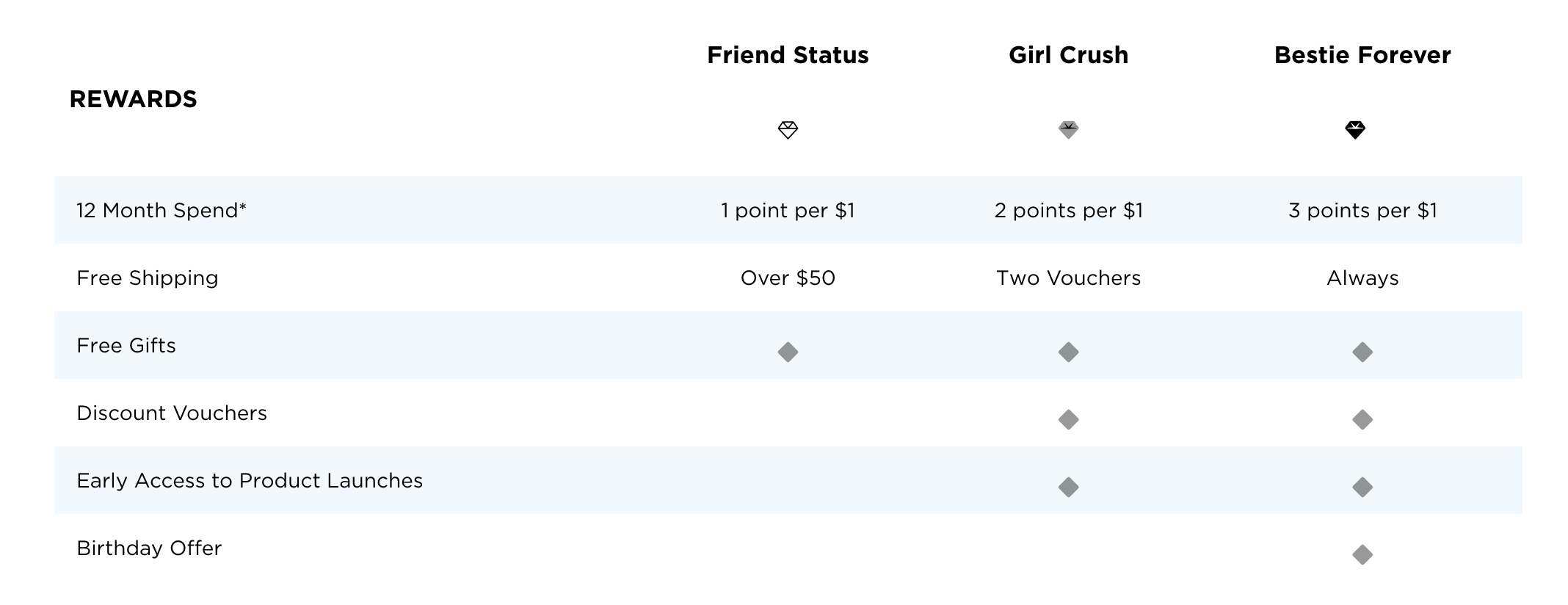
Encourage subscriptions
If your products are well suited to subscription purchases (like consumables that are replenished regularly, like hero skincare products, coffee packs and supplements), why not add a subscriber-only VIP-tier?
Or, you could follow in the footsteps of popular dog food brand Pooch & Mutt, who gives subscribers 3x points on all purchases with its “Pooch Rewards” program:
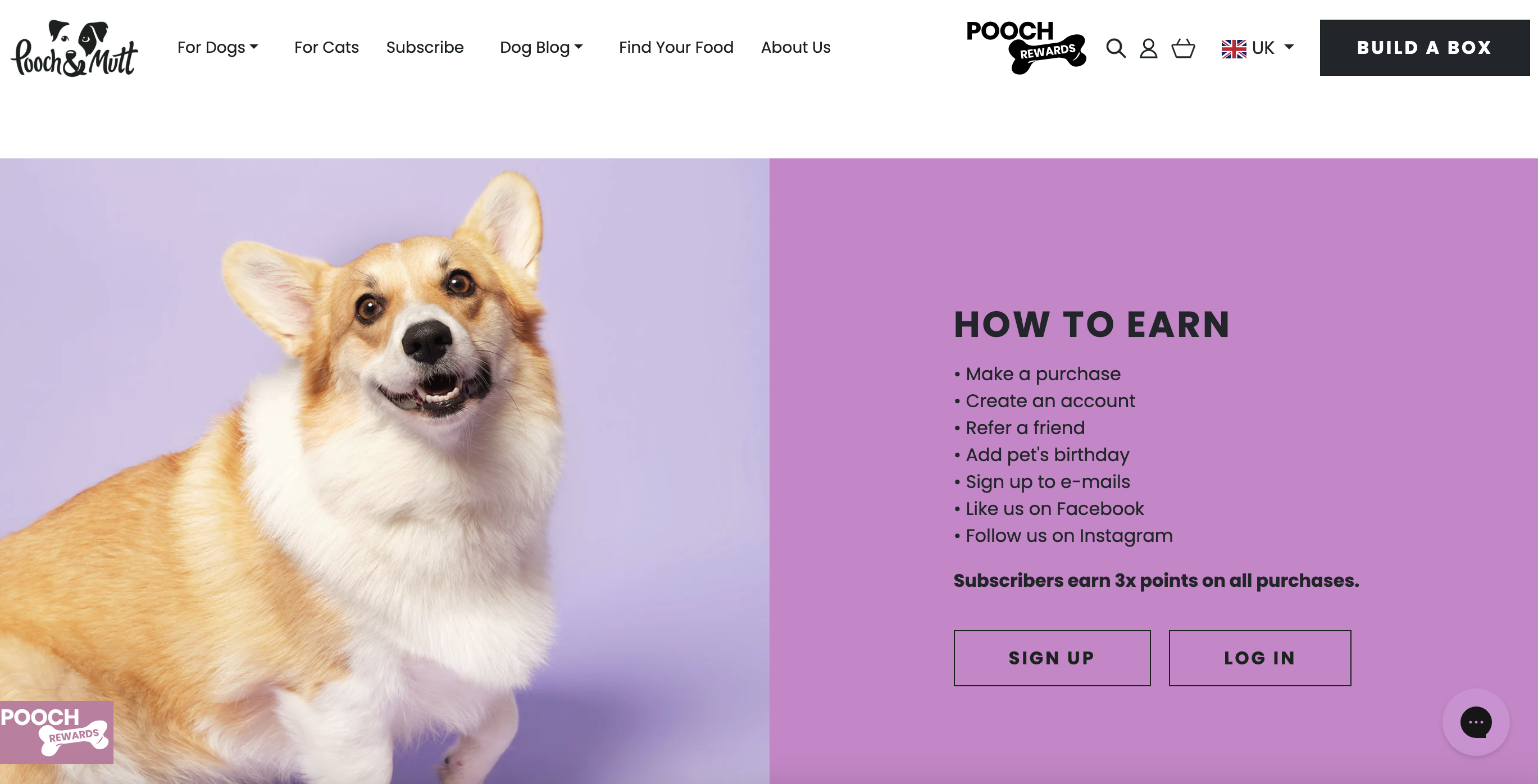
This presents an excellent opportunity to encourage more customers to sign up to your subscription by offering them unique rewards as a thank you. As well as upselling subscriptions to your existing customers, you’ll be able to draw in new members with attractive sign-up perks.
Subscribers represent a loyal customer segment with high CLTV, since they are committed to long-term spending cycles and are less likely to check out the competition. What’s more, a subscription model allows you to more easily manage inventory levels and forecast your cash flow.
You can read more about these advantages in our article on the benefits of subscription models.
4. Incorporate your loyalty program across the customer journey
Embedding loyalty components at various stages throughout the user journey can help you encourage new shoppers to sign up and maintain existing members’ engagement with your program – ultimately getting more out of your customers.
Here are a few examples of how you can embed loyalty throughout the customer journey, from product pages through to post-purchase.
Pop-ups
Pop-ups offer a great opportunity to promote your loyalty program on multiple pages across your store. They can alert new users to your program, as well as incentivise additional spend throughout the journey to purchase.
- Benefit-led pop-ups – These pop-ups should display the advantages for customers of joining your loyalty program. What sort of rewards can you offer them? Why should they sign up? Include immediate CTAs with tangible benefits, such as “Earn 100 points just for signing up”.
- Exit-intent pop-ups – Exit-intent pop-ups can be automated to display when customers show certain behaviours that signal they are about to leave your site – such as if their mouse is moving towards the ‘close window’ button or if they’ve been inactive for a set amount of time. Use these pop-ups to show customers what they will be missing out on if they decide to exit, such as the points they could earn for the products they’ve been browsing or the unique perks of your loyalty program.
- Promotional pop-ups – These types of pop-ups can be used across both your home and product pages, showcasing things like double point deals or seasonal campaigns. Make these deals time-specific to create a sense of urgency, and try linking these pop-ups to customer behaviour. For example, you could give anyone whose cart is under your AOV the opportunity to earn bonus points if they increase their spend.
- Emotional pop-ups – Pop-ups can also serve as a perfect opportunity to share what you stand for as a brand. If you pride yourself on supporting a social or environmental cause, use your pop-ups to tell your customers that they can spend their loyalty points on charitable donations.
Upsell on product pages
To reduce drop-off on product pages, remind customers of the loyalty points they could earn if they buy the product they’re viewing. This extra incentive could be enough to convince them to make the purchase, if they are hesitating.
It’s also a great way to upsell and cross-sell on your product pages. Alongside your product recommendations, display how many points each additional item would earn them.
Don’t forget to notify customers if they’re near a point threshold. If they aren’t far off their goal, they’ll be more likely to want to increase their order value to meet the criteria.
Checkout rewards
Let customers see the points value of their current basket and how many points they still need to redeem before they can claim a reward. This encourages customers to add more items to their cart and increase their order value.
Allow customers to easily apply loyalty points to their purchase with the help of a check-out slider. By enabling customers to claim rewards at checkout with one click – rather than confusing the process with voucher codes – you can benefit from increased program engagement.
Here, beauty and cosmetics brand Revolution makes it easy for this loyalty program member to apply the rewards they’ve earned in the cart:
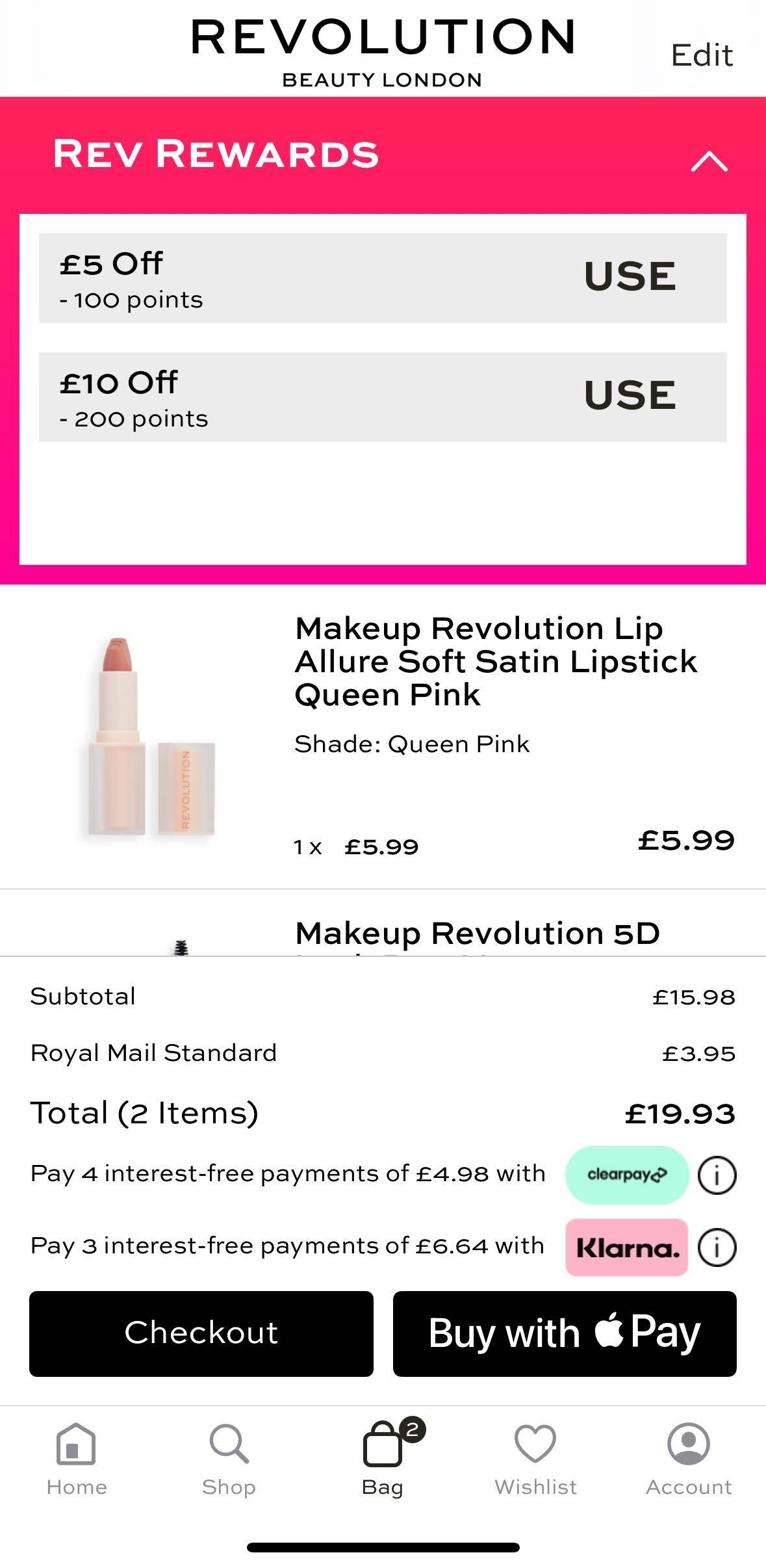
Post-purchase
The opportunity to secure longer-term customer loyalty doesn’t end once a customer has completed their purchase. There are ample opportunities to keep up program engagement post-purchase.
- Encourage guests to create accounts post-purchase –If a customer has completed their purchase as a guest, encourage them to sign up as a member of your loyalty program. This way, you’ll have more opportunities to build a relationship with them further down the line. At the checkout and in post-purchase emails, present the immediate value of creating an account – whether that’s extra loyalty points, a special discount or a free gift.
- Motivate future purchases with points reminders –In your order confirmation emails, notify a customer how many loyalty points they have as a result of their purchase, as well what threshold they need to reach to get their next reward. This simple tactic can encourage the customer to shop again with you – and soon. Using Revolution as an example again, this simple loyalty element in its automatic order confirmation email can help inspire a repeat purchase:
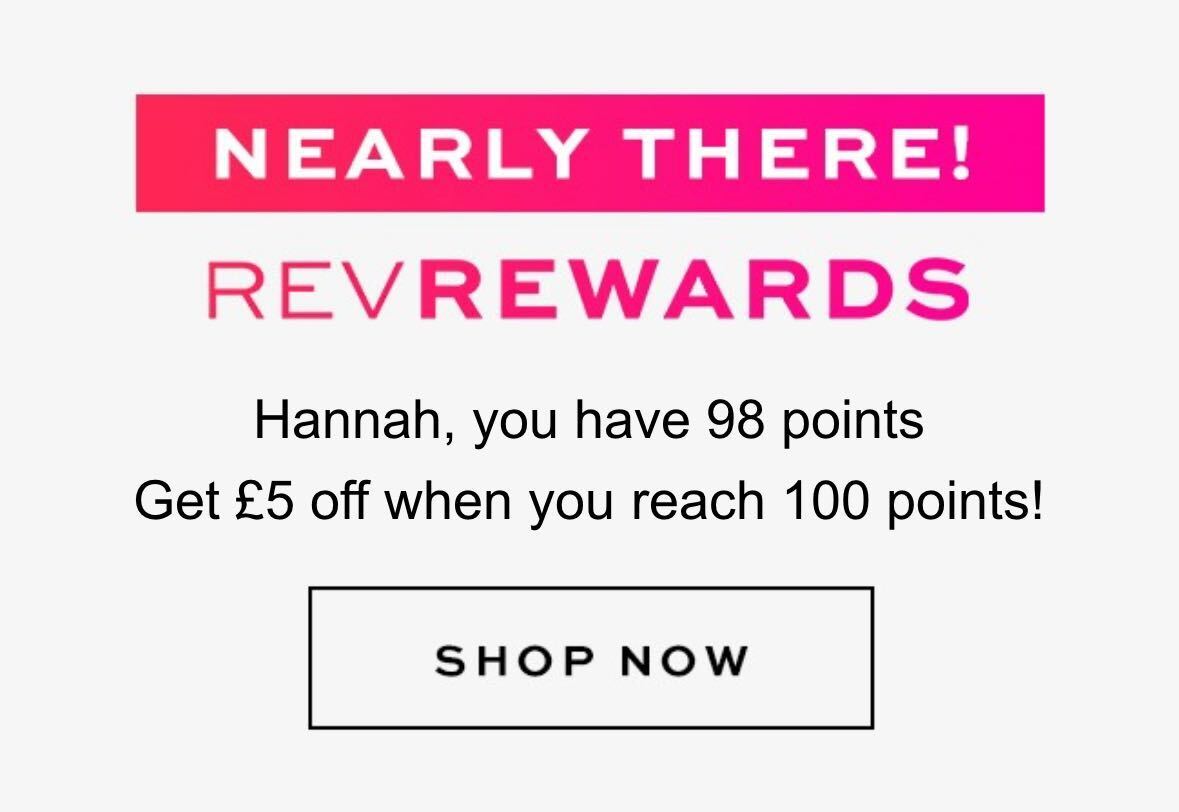
- Highlight other ways to earn points – On post-purchase pages, showcase other ways your loyalty program members can earn points, beyond making purchases. This is the perfect opportunity to show them that they can earn points for leaving a review on the product they just bought, or if they refer a friend to your store. Use this post-purchase opportunity to get your already loyal customers to act as advocates on your behalf. Other options for shoppers to earn points could include following your brand on social media or liking your posts. As well as promoting your brand, this ensures your loyal customers will continue to keep you top of mind when they are browsing these platforms in future.
5. Build a community with your loyalty program
Some of the most successful ecommerce loyalty programs can create devoted communities around a brand. Whilst points and rewards are very effective at motivating shoppers, being part of something ‘bigger’ can also be a source of inspiration.
Being part of an exclusive community gives customers the sensation of being VIPs, whilst providing a sense of belonging. They can connect with like-minded individuals whose mutual affinity to your brand will cultivate an even greater connection – both to the brand and to each other. This is great for fostering high levels of retention and encouraging referrals to friends and family.
Your community will form a compelling part of your overall brand experience, creating value for program members. This can help to entice new sign-ups, whilst encouraging existing members to stick around.
Plus, you can use this community space to trial new products, source ideas, and ask for customer feedback.
Examples of the benefits of loyal community members
To build its customer community, The Pulse Boutique created a private VIP Style group on Facebook for customers to unite around their shared love of fashion. Alongside exclusive early access to new stock and discount codes posted by the brand, members from across the US use the platform to discuss style tips and share photos of their latest Pulse purchases. The group has helped Pulse build a loyal following of enthusiastic brand advocates.
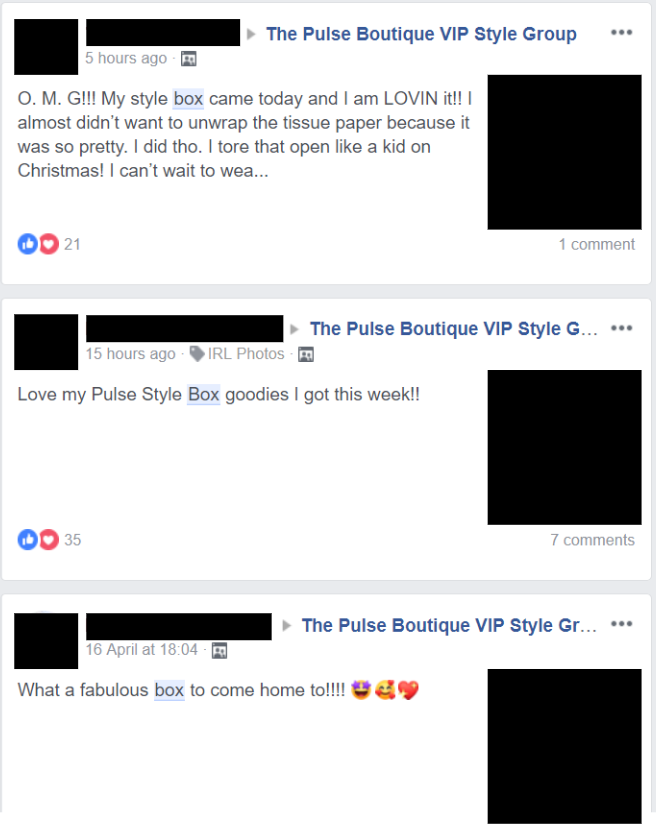
In another example, The British Blanket Company used a new product launch as an opportunity to make its loyal customers feel valued by the brand. These members were invited to vote on their favourite design, out of four options, and the most popular two designs were turned into new blanket patterns. If a customer feels they have contributed to the creation of a product, they’ll immediately feel a greater connection with that product and be more likely to make a purchase.
Use social platforms for two-way communication
Tempting as it is to view your social channels as a way to disseminate promotional material and messaging, these spaces are equally valuable as a way to foster a sense of community amongst your loyal shoppers and listen to what they have to say.
Interact with and respond to your customers’ messages and comments, to make them feel valued on an individual level. This is also a great place to get feedback from your customers, that you can use to improve your offering further.
6. Make your loyalty program omnichannel
Today, 50% of customers use more than four touch points when buying from a brand.1 When it comes to building a successful loyalty program, interacting with customers across these touch points, across multiple channels, is key. After all, retailers with omnichannel customer engagement strategies retain, on average, 89% of their customers.2
Making your loyalty program omnichannel involves recognising and engaging with your customers as the same person wherever they choose to interact with you. For hybrid retailers with both physical and digital stores, this means your customers can earn points and redeem rewards both in-person and online.
Do this correctly and you’ll be able to provide a more consistent shopping experience for your program members that increases customer satisfaction and helps to differentiate your brand from competitors. You’ll also benefit from a deeper understanding of how your most loyal customers interact with your brand, helping you to identify opportunities for evolving your loyalty program.
Link your loyalty program app with Shopify POS
Here are some ways for hybrid retailers to unify the loyalty program experience using Shopify POS:
- If you have multiple physical retail locations, make sure these are connected so customers can collect and redeem points across all locations.
- Convert in-store shoppers to digital customers by rewarding them points that they can redeem for rewards online.
- Send customers loyalty notifications via email whenever they make a purchase – offline or online.
We explore how hybrid retailers can better connect offline and online commerce through POS in this article about destination brands driving repeat purchases.
7. Incentivise brand advocacy
More than 80% of shoppers do research online before committing to a purchase.3 Having your existing customers publicly advocating for your brand reduces the time and effort spent on this research, increasing consumers’ confidence in your brand and products.
Advocacy works because people are more likely to trust others, just like them, over other forms of advertising that are tarnished as inauthentic. Our peers’ opinions about an experience with a product or brand is more impactful than other forms of marketing.
There are two main types of advocacy you can encourage with your loyalty program: reviews and referrals.
Reviews
Positive reviews are especially important in the world of ecommerce, where shoppers are unable to physically inspect a product before buying it and there are no store assistants to answer questions or provide guidance. We rely on the genuine feedback of others to help us make the right purchasing decisions.
Social proof is a powerful way to build confidence in new users – particularly reviews that feature visual user-generated content such as photos or video of prior customers using your product. New and curious shoppers can see your products being used and enjoyed by real people, just like them.
Reward your customers with loyalty points for every review they leave on a product – you could even add bonus points if they include a photo or a video alongside their write up. This will result in more reviews for your ecommerce store, which can be leveraged across your social channels too, as well as helping in converting browsers into buyers.
For more ideas on how you can leverage your customer reviews, take a look at our article on social proof examples.
Referrals
Customers tend to trust recommendations that come directly from someone they know, so referrals are an important customer behaviour to encourage.
On average, referred customers spend 11x more on their first purchase and 8% more on future orders.4 They are also 5x more likely to introduce others to your brand. Referrals are a cost-effective way to acquire and inspire new shoppers who are, on average, themselves more loyal to your brand.
Encourage your existing customers to refer others to your site by using loyalty points as an incentive.
You need to make it as easy as possible for your customers to refer their friends – otherwise, they won’t do it. Assign each customer with a unique referral URL that they can share – this lets you track who your strongest advocates are, so you can reward them further down the line.
To encourage your customers to make referrals, make sure all parties involved will benefit from their efforts by rewarding both the referred customer and the program member who made the referral. For example, you could give your existing customer a money-off voucher for when their referred friend makes a purchase, whilst the new customer gets 10% off their first order when using the referral link. This provides both customers with immediate benefits and demonstrates to your newly acquired customer that you value them from the get-go.
Pish Posh Baby incentivises brand advocacy by rewarding both reviews and referrals. Note how the brand offers more points for submitting a review with an image or a video.
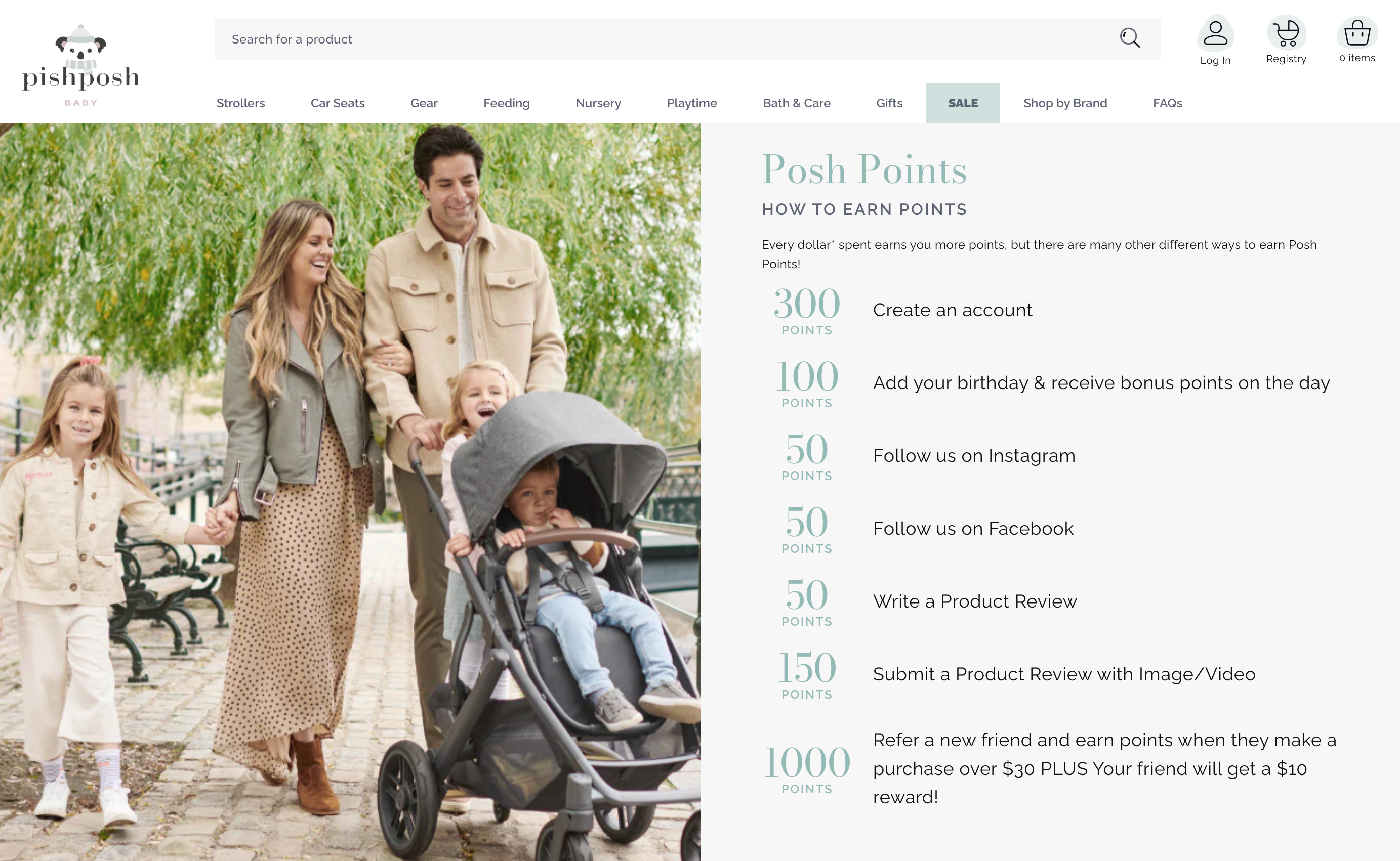
For more on the topic of referrals, check out this article from advocacy platform Mention Me on how to create an effective refer-a-friend program.
8. Automate your ecommerce loyalty program
Despite being aware of the benefits that a loyalty program could bring their brand, many of which we’ve discussed in this guide, retailers can sometimes be deterred from creating one because they believe it will be too onerous to maintain. When there are stock levels to manage, customer queries to respond to and social content to react to, setting up and maintaining a loyalty program can quickly fall down the list of priorities.
However, whilst it’s tempting to focus solely on these immediate concerns, fostering loyalty and encouraging repeat purchases is what will ultimately guarantee your long-term stability. Did you know that a 5% increase in your customer retention can correlate to a 25% increase in profit?5
When it comes to reducing the burden of maintaining a loyalty program, automation can be transformative. Many retailers link their loyalty tool with their email marketing solution, configuring triggers and actions to manage their loyalty program and communicate with members on an automated basis. Below are some examples of how you can do this.
Convert guest shoppers into account holders
Trigger: A customer makes a purchase as a guest.
Action: Send an email to tell the customer they’ll earn loyalty points if they create an account.
Benefit: This increases the likelihood of customers coming back to your store to earn more points and reach rewards.
Surprise and delight members with a birthday gift
Trigger: A program member’s birthday is in a week’s time.
Action: Send an email notifying them of their birthday gift and recommending relevant products.
Benefit: This demonstrates to customers that you value them on an individual level, and is something they’re likely to tell others about.
Reward your already loyal customers
Trigger: A customer completes the right amount of orders to move them to a higher tier.
Action: Award the customer bonus points for being a repeat customer and send a congratulatory email.
Benefit: This shows customers that you recognise and appreciate their loyalty – strengthening brand-consumer identification and encouraging advocacy.
Re-engage at-risk customers
Trigger: A program member moves into your at-risk criteria (for example, they haven’t visited your site or made a purchase in a set timeframe).
Action: Award points and send an email telling them about the surprise points you’ve gifted them.
Benefit: This could help you avoid losing a customer.
Ready to build a loyalty program for your ecommerce brand?
Crafting the perfect ecommerce loyalty program is about understanding your customers and using that knowledge to create a program that will resonate with members and help meet your objectives as a business.
From selecting the right rewards to integrating the best technology, every element matters in making a program that engages, excites and retains customers.
As you roll out your loyalty program strategy, perhaps including some of the initiatives we’ve shared in this guide, be ready to tweak your program and evolve it in line with your customers’ needs. Done right, your loyalty program will not just boost sales but will also carve out a lasting place for your brand in the hearts and minds of your customers.
At Swanky, we’ve worked with retailers around the globe to help them retain more customers. Our approach is based on an understanding of your commercial goals and deep analysis of customer behaviour to design an ecommerce loyalty program that meets both your brand’s and your customers’ needs.
Get in touch with our team of customer retention experts for more information on how we can help.
For reference:
[1] https://www.hubtype.com/blog/omnichannel-customer-support
[2] https://blog.softtek.com/en/omnichannel-strategies-help-retain-89-of-customers
[3] https://saleslion.io/sales-statistics/81-of-shoppers-research-their-product-online-before-purchasing/
[4] https://www.mention-me.com/blog/strategic-referral-marketing-and-customer-advocacy
[5] https://media.bain.com/Images/BB_Prescription_cutting_costs.pdf

